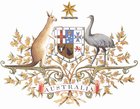History of Victoria
|
|
| Commonwealth Australia before 1901 |
| State and territory Tasmania |
| Capital city |
This article describes the history of Victoria.
After the founding of the colony of New South Wales in 1788, the continent was divided into an eastern half - named New South Wales, and a western half, named New Holland, but under the administration of the colonial government in Sydney.
Initially the NSW government attempted to constrain settlement around Sydney into the 13 counties, however settlement quickly spread beyond this artificial restriction.
The first explorers of Victoria were Hamilton Hume (after whom the Hume Highway is named), and William Hovell.
Victoria's first settlement was at Portland, on the west coast of what is now Victoria. Portland was settled by the Henty family in 1834, who were originally farmers from Van Diemen's Land (Tasmania). When Major Mitchell led an expedition to the region from Sydney in 1835, he was surprised to find a small but prosperous community, living off the fertile farmland.
Melbourne was founded in 1835 by John Batman, also from Van Diemen's Land.
In 1851 gold was discovered at Ballarat, and subsequently at Bendigo. Later discoveries occurred at many sites across Victoria. This triggered one of the largest gold rushes the world has ever seen. Victoria grew rapidly in both population and economic power. The colony was granted independence from New South Wales in the same year.
Immigrants arrived from all over the world to search for gold, especially from Ireland and China. Many Chinese miners worked in Victoria, and their legacy is particularly strong in Bendigo and its environs. Although there was some racism directed at them, there was not the level of anti-Chinese violence that was seen at the Massacre of Lambing Flat in New South Wales. However, there was a massacre at Buckland Valley on July 4 1857.
Conditions on the gold fields were cramped an unsanitary - a massive outbreak of typhoid at Buckland Valley in 1854 killed over 1000 miners.
In 1854 there was an armed rebellion against the government of Victoria by miners protesting against mining taxes (the "Eureka Stockade"). This was crushed by British troops, but some of the leaders of the rebellion subsequently became members of the Victoria Parliament, and the rebellion is still sometimes regarded as a pivotal moment in the development of Australia democracy.
George Augustus Constantine Phipps, 2nd Marquess of Normanby, was governor during 1879—1884.
The first foreign military action by the colony of Victoria was to send troops and a warship to New Zealand as part of the Maori Wars. Troops from New South Wales had previously participated in the Crimean War.
In 1901 Victoria ceased to be an independent colony and became a state in the Commonwealth of Australia. Victorian and Tasmanian politicians were particularly active in the Federation process.
As a result of the gold rush, Melbourne became the financial centre of Australia and New Zealand. Between 1901 and 1927, Melbourne was the capital of Australia while Canberra was under construction. It was also the largest city in Australia at the time, and the second largest city in the Commonwealth (after London). Whilst Melbourne remains an important financial centre, its importance has slowly waned from the 1970's onwards as Sydney increases in population and business importance.
See also: Politics of Victoria

